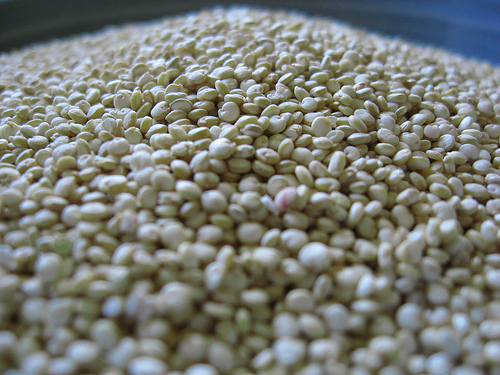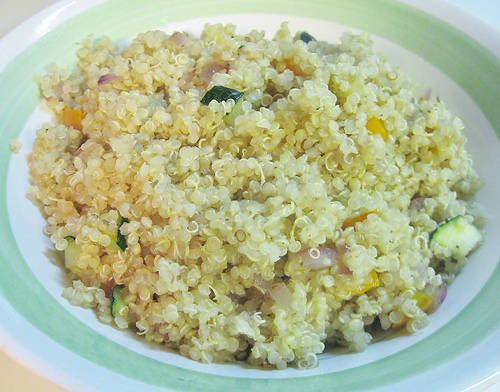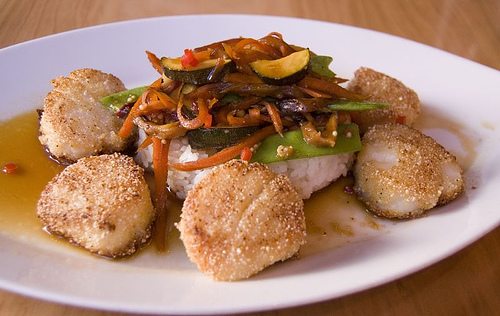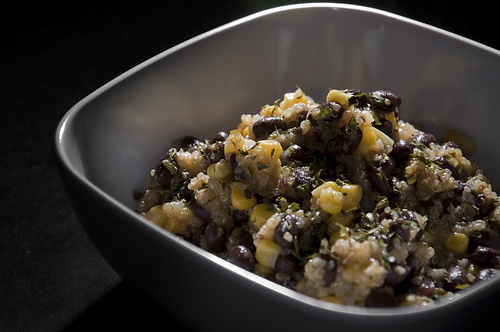What's the deal with quinoa?

After reading about how 2013 is the "International Year of Quinoa," and how quinoa's popularity has turned it into a cash crop in Bolivia (which is problematic for the Bolivians who choose to grow it), I was motivated to give this grain a try.
Quinoa is incredibly nutritious, with a high fiber and protein content, and jam-packed with a list of vital nutrients as long as your arm. When it comes to starches, quinoa comes out so far ahead that it's the only grain which the carb-hating Dr. Lustig encourages people to eat.
But, like… how do you eat it? This was my question as I stared at the box I brought home from the store. It included a recipe for "quinoa pilaf" which did not look particularly delicious or helpful.
Here's what I have learned about quinoa since then:
1. Quinoa is ridiculously filling
If you are used to having some potatoes, sweet potatoes, rice, or other starches with your meal, you will probably want to adjust your quinoa serving size. I find that a portion of quinoa is about five times more filling than those other, lesser carbs. It's easy to accidentally stuff yourself to an uncomfortable point.

Confetti Quinoa, image courtesy Flickr/SaucyGlo. Get the recipe here.
2. You can cook it in a rice cooker
If you're fortunate enough to have a rice cooker, you can cook quinoa in there no problem. It's the same ratio as rice (1 part quinoa to 2 parts water). In my rice cooker, it takes about half an hour to cook - longer than white rice, but not as long as brown rice.
One difference is that in my experience, quinoa is a lot more sticky and likely to adhere to the sides of the pot. I have learned to add olive oil first, and rub it all around the inside of the cooking pot before putting in the grain and water. Even then, I have to soak the pot for a while before cleaning it.
3. It keeps well
I will cook up a big batch of quinoa, then put the rest in the fridge. You can reheat it in the microwave without losing any of the texture or flavor (such as it is).

Quinoa-crusted scallops, image courtesy Flickr/ulterior epicure.
4. Don't look at it too closely.
It looks like fish eggs or tapioca pearls. Just pretend you're eating regular rice grains.
5. The flavor is unremarkable
I keep reading about how quinoa has a "rich" or "nutty" flavor. Maybe those people are eating a different variety. The stuff I have been buying has more of a taste than white rice, but less than brown rice. (Although unlike white rice, it doesn't taste sweet.) And no matter how much salt I add, it never seems to affect the taste. Flavor-wise, quinoa is a bit like a black hole.

Quinoa and black beans, image courtesy Flickr/jk5854. Get the recipe here.
6. It works OK as a side dish, as long as you're eating something saucy
If you are used to adding a dollop of rice or potatoes alongside your main dish, you can pretty much do this with quinoa too. As long as whatever else you're eating has sauce or a strong flavor that you can kinda mix in with the quinoa, that is. You can certainly eat it on its own, but it's a little bit… drab.
Case in point: I used to make home fries and serve them with fried eggs. When I went low carb, I swapped quinoa for the home fries. But to compensate for the blandness of the quinoa, I also add a splash of hot sauce or a dollop of chili garlic sauce.
7. It isn't sticky
If you use rice or potatoes in recipes, be aware that quinoa (because it is so un-starchy) doesn't have that property of stickiness that you may be used to.
Case in point: Another dish I often make is croquettes. I used to make these with leftover mashed potato, one egg and a can of salmon. When I make them with quinoa, I add an extra egg, because otherwise the quinoa will crumble apart.
8. It's expensive!
Quinoa is still something of a "boutique grain." At my local grocery store, it sells for about $10 per pound. (Compare that to $1/lb for potatoes, or $2/lb for brown rice.)
You can often find quinoa in bulk, but be aware that some forms of quinoa need to be rinsed before you eat them, or else they will taste bitter. I have heard that bulk quinoa often has not been pre-rinsed. And there is no way I'm going to all the trouble of trying to rinse quinoa! All those tiny grains.
Main image courtesy Flickr/Flickered!

0 comments